Review the 470 and 500 Nitro Express Cartridges
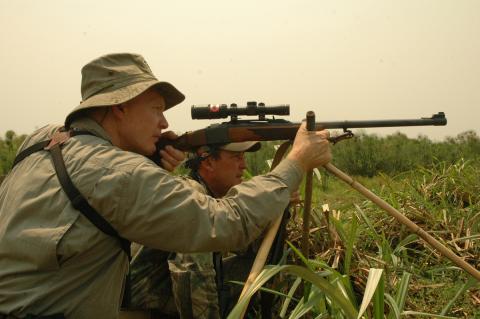
Planning the perfect safari bombardment is always a challenge. With Africa'south peachy variety information technology's most impossible to be perfectly armed for everything ane might encounter. In the old days, the African battery was typically three rifles: "Light" for modest to medium plains game; "medium" for the largest antelope and perhaps king of beasts; and a "heavy" for the large stuff — and sometimes information technology's fun to accept a shotgun as well! Today information technology's increasingly hard to take more than than two firearms on safari, which means nosotros take to compromise.
In 2017, headed to Mozambique, I didn't take a "buffalo rifle." That is uncharacteristic because hunting those swamp buffaloes is e'er a primary pursuit. Fortunately, I knew my buddy Gordon Marsh was taking his Sabatti double chambered to .450/.400-3" Nitro Limited (NE). I knew we could share it, and among our camp that piffling rifle deemed for four buffaloes. There were six shots expended, no runners, all down within a few yards.
I beloved the .450/.400 for buffalo! Nosotros take the first modern Heym chambered to this cartridge, and also a scoped Ruger No. i and then chambered. Both are slap-up rifles with several buffaloes to their credit, and the Heym has accounted for a couple of elephants. But back in Mozambique in 2018, I didn't have a .450/.400, and Gordon wouldn't be at that place with his. Instead, I took another Sabatti double in .450-3 one/4" Nitro Express (NE). I likewise used it in Caprivi, two buffalo bulls down, no problems. Both cartridges are amid my all-fourth dimension favorite dangerous game cartridges. Both are (originally) British Nitro Express cartridges dating to cease of the 19th Century, and both are extremely viable today. Although their designations start with ".450," they couldn't exist more than different!
WHAT'Due south IN A NAME?
The name of a cartridge should give usa some idea of the bullet and diameter diameter, and perhaps some inkling of the power level. All the same, we round numbers up and downwardly, and there are American, British and European protocols with exceptions to every rule. The .450-iii 1/iv" NE is straightforward. Developed past John Rigby in 1898, it was the commencement big-caliber cartridge designed specifically for smokeless propellant (nitrocellulose-based, thus "Nitro Limited"). The .500 and .577 NEs preceded information technology, but both were based on existing blackpowder cases. ".450" is the nominal bullet bore, really .458-inch, rounded downwardly. The British often appended the case length, as in .450-three one/iv", 3.25-inch case. The case is rimmed, intended for use in double rifles and single shots for ease of extraction, and is straight with gradual body taper. Information technology was occasionally called the ".450 Direct" and is also referred to every bit ".450 NE."
Despite the showtime office of its designation, the .450/.400-3" is a totally unlike cartridge with much reduced power level. Taking an existing cartridge instance and changing the cervix bore (thus bullet diameter) has been mutual as long as there have been metallic cartridge cases. Americans tend to use the bodily bullet diameter first, sometimes referencing the parent case second: ".25-'06" is a .25-quotient cartridge based on the .30-'06 case necked downward; the "7mm-08" is a 7mm (.284-inch) cartridge based on the .308 Winchester case necked down. The British tend to use the parent case start, followed past the gauge bullet diameter. And so, the .450/.400-3" is not a .450-caliber cartridge at all! It is a .450 example necked down to accept a .40-caliber (actually .410-inch) bullet, and it uses a iii-inch case.
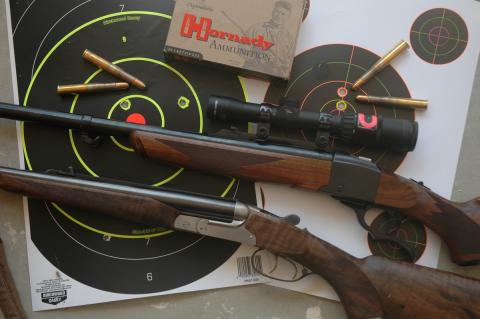
There are two versions. The .450/.400-3 ane/4" NE dates to the early 1890s and was based on a blackpowder cartridge case necked downwards to .40-caliber and using a 3.25-inch long case. At higher smokeless powder pressures, there were some early on issues with weak cases designed for low blackpowder pressures. Stronger cases solved that, but John Rigby was undoubtedly because reliable extraction when he developed his .450-three 1/4" cartridge.
At about the aforementioned fourth dimension, using heavier brass with a thicker rim and shorter case, the rival firm of W.J. Jeffery introduced the .450/.400-3", ordinarily also known every bit the ".400 Jeffery." Both case lengths were popular, and although ballistics are well-nigh identical, the ii are non interchangeable. That complicates the picture a bit but, although there are other .450-quotient Nitro Express cartridges, there is only one .450-3 one/four" NE and in that location is simply one .450/.400-3" NE. Despite the confusing nomenclature, they are unlike cartridges with different purposes, and both accept made pregnant comebacks.
BRINGING 'EM Back
After World War II, Not bad Britain began releasing far-flung colonies in both Africa and Asia. With a greatly reduced market, the British gun trade floundered and Kynoch started discontinuing production of Nitro Limited cartridges, a process that was complete past the mid-1960s. For 20 years ammunition grew ever scarcer for the British big bores. Aging ammunition (and brass!) was carefully hoarded while American handloaders used RCBS dies and Barnes bullets. In the mid-1980s Randy Bell of Brass Extrusion Laboratories Ltd. (BELL) offered new cases. New rifles from Heym, Krieghoff, Merkel, American Butch Searcy and others rekindled interest in double rifles, but initially it was mostly a .470 Nitro Express world.
The .500 Nitro Limited made a balmy resurgence, and in 1996 Krieghoff introduced the .500/.416-3 1/4" NE. Both the .470 and .500 are great cartridges, and the .500/.416 is awesome, but with a 400-grain bullet at 2,350 anxiety per second (fps) it develops virtually the same energy as the .470, thus has pretty much the same recoil.
In the 1990s I had a lovely boxlock .450/.400-3" by unknown British maker Thomas Turner. Hard-hit but mild in recoil, I loved it and should take kept it! In the early 2000s, with doubles condign always more popular, information technology seemed to me there was a demand for an constructive medium-ability double rifle cartridge that didn't kicking y'all into next calendar week.
Hornady was interested in expanding its "Unsafe Game" line, and so while in camp in the Zambezi Valley I talked Steve Hornady and Ruger'due south Randall Pence into taking a look at the .450/.400-iii". Ruger made a run of No. 1 unmarried shots in .450/.400-iii" and, over time, virtually all current makers of modern double rifles adopted the chambering. With a 400-grain bullet at about 2,100 fps, the .450/.400 develops around 4,000 ft.-lbs. of energy. In the sometime days it was considered adequate for any large bovine, and adequate for elephant, simply with much less recoil than the big bores.
This resurrection was not without challenges. Both the not-interchangeable .450/.400-iii 1/4" and .450/.400-3" were popular and chambered by many makers. The longer version, as originally loaded, was a bit faster and slightly more powerful. My opinion remains that the three-inch version was more than popular, but in that location is no proof that is correct. Gunwriting colleague Ross Seyfried, extremely knowledgeable on such things, thought I was incorrect and gave both me and Hornady grief for choosing the three-inch version. Still, my recommendation wasn't based on whim. The British loaded Cordite, an early smokeless propellant formed in long sticks or "cords" that was highly volatile. They always used actress-big cases for more expansion during ignition and thus lower pressure. With modern propellants, the bigger cases serve little purpose. Both .450/.400s existence essentially equal in operation, I figured we'd go improve load density (less empty space) using modern powders in the iii-inch case. Anyway, washed is done. The .450/.400-3" has become extremely popular in new doubles and is also a wonderful choice in unmarried-shots. The .450/.400-three ane/4" is available from other sources, but few new rifles are so chambered today and the .450/.400-3" has been a solid winner.
In big-bore double rifles the .470 is King, probably followed by the .500-3" NE. The .470 is excellent for everything up to pocket-sized armored cars, but the .500 gives you a chip more than with little increment in recoil. Thing is, the .470 and .500 share the same rim and base bore. I've had several .470s over the years, and currently have a Krieghoff in .500-iii". Y'all won't catch me knocking either cartridge, both are superb, however, I'grand allowed to have favorites.
My favorite big-bore double burglarize cartridge has long been the .450-three ane/4". The reasons are subtle. From the .450s upwardly through the .465, .470, the three .475s and the .476, performance is identical: Roundabout 480- to 520-grain bullets at about two,150 fps with around five,000 ft.-lbs. of energy. The .470 won the popularity race but, over again, only the .500 gives you a wee bit more.
Bated from being the original 1898 cartridge that fix the standard, the .450-3 1/4" has a smaller base diameter than the rest, most of which are based on the .500 example necked down. That means information technology can exist housed in a trimmer action. In 1956 the .458 Winchester Magnum made the .458-inch bullet a world-broad standard. With so many bullet choices to today, this isn't as important, only everybody who makes large-caliber bullets makes .458-inch bullets. Finding .458-inch bullets is never a problem! Besides, since information technology has a direct example rather than bottleneck, the load density advantage applies.
Yes, 'twas me who convinced Hornady to bring back the .450-3 1/4" in a modern load, and God bless them. Since it uses a smaller rim and base diameter than .500-based cartridges (including the .470), another small rationale was that the .450 3 i/4" NE is essentially the largest existing cartridge that tin be housed in the Ruger No. one action without hogging out the lesser of the receiver. Ruger has done runs of No. 1s in this cartridge, merely it has not been as successful every bit the .450/.400-3". In a lighter burglarize like the Ruger single shot, recoil is snappy!
Although both the .450/.400 and .450- iii 1/four" projects seemed quite straightforward, there were issues. References propose .411 as the correct bullet diameter for the .450/.400-3". In actual fact, .450/.400s vary more in bore diameter than virtually British cartridges. Perhaps that is because they were offered by so many small-scale shops, merely older .450/.400s can exist encountered with bores as loose as .412-inch and as tight as .408-inch.
Modern rifles are standardized at .410, and that is the bullet diameter Hornady settled on. In older rifles it's a adept idea to slug your diameter and observe out exactly what you're dealing with. Since the .458 Winchester Magnum came out, 500 grains has been the standard .458-inch bullet weight. John Rigby'southward original bullet for his .450-3 i/4" was 480 grains. Hornady started with 500-grain bullets in its initial Dangerous Game loads. A four percent difference in bullet weight won't make a difference to any pachyderm!
I've shot a lot of 500-grain bullets in my .450 doubles and, so long as velocity is normal, regulation has been fine. All the same, doubles are notoriously finicky; Hornady's current .450-3 1/four" loads, in both DGX-Bonded and DGS, are 480 grains.
.450/.400 YESTERDAY AND TODAY
Taken together, the two .450/.400s were hands the most mutual chamberings in larger-quotient British doubles. Individually, each was probably more popular than several of the big bores. Role of this is sheer utility. We tend to forget that far more vintage British doubles went to India than to Africa. The .450/.400 was considered perfect for tiger, and of form was Jim Corbett'southward option. Even so, we also forget that, in add-on to tiger, India had more than varieties of dangerous game than Africa: Elephant, rhino, gaur, h2o buffalo, sloth behave and both lions and leopards. The .450/.400 was considered perfectly adequate for the Asian jungle and for the African bush.
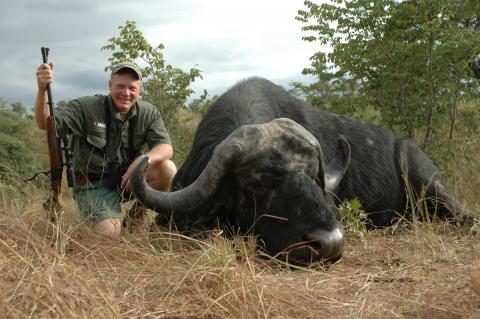
With a 400-grain bullet at around 2,100 fps, information technology develops almost 4,000 ft.-lbs. of energy. This is 20 percent less bullet weight and energy than the .450 and .470, and a greater reduction in recoil. Penetration is excellent, and no ane, including John Taylor (who loved large bores), has ever suggested that the .450/.400 is inadequate for elephant. Without question the big bores are more adequate, but the .450/.400 is a whole lot easier to shoot (and to shoot well).
Prior to Hornady's resurrection, nobody really wanted a .450/.400. Information technology didn't take the sex appeal of the large bores, and ammo was scarce. Older rifles were plentiful and at a fraction the cost of, say, a .470 (which is the cartridge everyone wanted). Things have changed, and all vintage doubles have skyrocketed in value. However, the .450/.400 is at present an important function of today'due south double burglarize world. Everybody makes them. Considering the mild "paper ballistics," effect is awesome and they are fun to shoot. Since they're fun, yous will shoot a .450/.400 more than and shoot information technology better. And it actually is manageable! Donna has used the .450/.400-3" in both single shots and double rifles and has used it for both buffalo and elephant. It does its work very well without hurting yous.
.450-iii 1/iv" YESTERDAY AND TODAY
Although I'thousand in the minority, I think the .450-3 one/four" is the best of the British big bores for double rifles. Information technology could take become the dominant double rifle cartridge just for two things. Offset, the British proprietary system. All British gunmakers were small shops compared to a Remington or Winchester and the larger houses had to have their own cartridges. The .450-3 one/4" belonged to Rigby.
Kingdom of the netherlands & The netherlands soon followed with its .500/.450. Developed by Eley, an ammo visitor and thus not a proprietary, the .450 No. ii followed with a massive 3.v-inch case, but like ballistics. The .450 No. 2 was popular, but in about 1907, because of unrest, the .450-caliber was banned in India and Sudan (aforementioned bullet diameter every bit the .577/.450 Martini Henry cartridge).
That opened the floodgate. In a couple of years, the Brits had .500/.465, .470, .475, .475 No. 2, .475 No. ii Jeffery and .476 Nitro Express cartridges — all with similar ballistics. The .470 emerged as the most pop today, only "in the day" there were no clear winners.
Even so, the .450-3 1/iv" had its following. Kermit Roosevelt used one in 1909 while Theodore Roosevelt used his famous .500/.450. Denys Finch-Hatton used a Rigby .450-3 1/4", as did more recent ivory hunters such as John Taylor and Ian Nyschens. Today, for better or worse, the .450-3 i/4" isn't well-nigh every bit popular as the .470, although at least equally constructive. I got my first .470 nearly 40 years ago, but I always wanted a .450-3 1/4". Information technology took a while, but I've had one or another .450-3 1/iv" for virtually 20 years. At present, with armament more available than ever, the .450-3 one/iv" makes a sound alternative to the .470.
WHICH TO CHOOSE?
As with near cartridge selections, information technology depends largely on what you intend to do with it. Although clearly very effective, I've taken but few buffaloes with the .450-iii one/four", but several elephants. It has a lot of recoil (aforementioned as the .470) which would be fine if necessary, just that level of power is not essential for buffalo. On the other manus, the .450-3 i/4" is superb for elephant; not necessarily better than the .470, but at least as good.
The situation is reversed on buffalo. Over the years, we've taken a lot of buffaloes with the .450/.400-three", and I'grand convinced it is exactly perfect: Not merely plenty of power, only visibly more than impact and effect than a .375 can deliver. I am certainly not suggesting it's "better" than the .416s. It'due south actually similar in consequence, but in a double rifle, which is usually a flake heavier than a commodities-action, information technology delivers well without undue punishment.
If y'all're looking for a double rifle that volition be used mostly for buffalo, then I recall the .450/.400-3" is the mode to go. It certainly has plenty of power for elephant, but the .450/400's strongest suit is buffalo. On the other hand, if you lot intend to concentrate on elephant, then the .450-iii 1/4" may be a improve choice. Of course, you tin ever follow the oversupply and get a .470 or take a pace up and get a .500. Today there are plenty of new rifles and lots of ammo. It's prissy to have choices!–Craig Boddington
Source: https://safariclub.org/a-tale-of-two-aeoe-450sae/
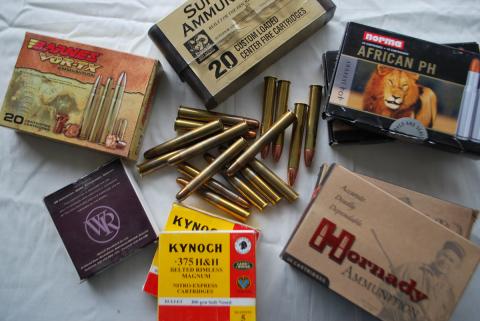
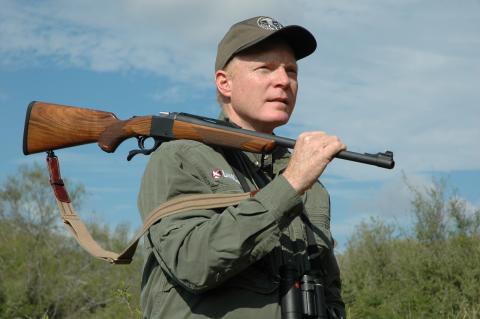
0 Response to "Review the 470 and 500 Nitro Express Cartridges"
Post a Comment